Non-Periodic Phenomena in Variable Stars
IAU Colloquium, Budapest, 1968
CORRELATIONS BETWEEN THE IRREGULARITIES OF THE PERIOD
AND RADIAL VELOCITY, LENGTH OF PERIOD, AMPLITUDE
AND SPECTRUM OF MIRA-VARIABLES
P. AHNERT
Institut für Sternphysik, Sternwarte Sonneberg, GDR
There are several well-known correlations between the abovementioned
properties. However, because there are remarkable differences between
slowly and rapidly moving Mira-stars (population I and II), I supposed
that there may also be different correlations for these two groups. I
have taken all Mira-stars of spectrum Me with radial velocities > 80
km/s (n = 23) and those with < 20 km/s (n = 42) from Merrill's Catalogue
(ApJ 94, 171; 1941), which are also mentioned in the "Studies of Long
Period Variables" by Leon Campbell (AAVSO 1955).
The comparing shows the following result:
Table 1
V mean(P) mean((M-m)/P) mean(Sp) sigma_p mean(A)
20 km/s 325d 0.436 M5. 42e +-2.69% 4.85m
80 236 0.450 M3. 89e +-3.33 4.24
(sigma_p = scattering of cycles in percents of the period.)
In the "Studies of Long Period Variables" Leon Campbell gives the times
and magnitudes of the maxima of these stars from 1920 to 1950 with the
single cycles, the mean period, the proportion (M-m)/P and the spectrum.
From these data I have computed the scattering of the cycles in days and
percents of the period and the scattering of the magnitudes of the maxima.
Let us regard the slowly moving group. As seen in Figure 1 there is a
loose relation between sigma_p and the spectrum in the sense that the
larger the scattering the earlier the sub-group of Me. The relation is
rather loose; it becomes more evident if we divide the spectra into some
groups (see the crosses). A corresponding relation exists between the
scattering and the length of the periods (Figure 2). But this
coincidence is trivial because it is a well-known fact that the longer
the period the later the sub-group of Me. And with regard to the
relation between the scattering of the cycles and the length of the
period we must take into consideration that the percentage of the
scattering must be higher at short periods, even if the scattering in
days is the same for long and short periods. Nevertheless the relation
seems to be at least partially real. (See also Table at the right side
of the diagram.)
List of the stars
(Other properties see L. Campbell, "Studies of Long Period Variables")
1. 23 Mira-stars v > 80 km/s
sigma_p
d %
004533 RR And +-8.8 +-2.66
004746a RV Cas +-8.5 +-2.56
052036 W Aur +-7.3 +-2.68
065208 X Mon +-9.1 +-5.86
073723 S Gem +-6.9 +-2.35
083350 X UMa +-6.8 +-2.71
090024 S Pyx +-7.4 +-3.60
110506 S Leo +-6.9 +-3.63
123160 T UMa +-6.6 +-2.58
153620a U Lib +-8.05 +-3.55
154536 X CrB +-6.1 +-2.53
155229 Z CrB +-6.6 +-2.64
155823 RZ Sco +-7.4 +-4.61
180531 T Her +-5.7 +-3.45
183308 X Oph +-10.2 +-3.04
193509 RV Aql +-6.6 +-3.03
194048 RT Cyg +-7.0 +-3.64
194348 TU Cyg +-6.2 +-2.81
200212 SY Aql +-10.3 +-2.91
200715a S Aql +-6.7 +-4.52
215934 RT Peg +-8.2 +-3.81
220613 Y Peg +-6.4 +-3.10
225914 RW Peg +-9.3 +-4.43
2. 42 Mira-stars v < 20 km/s
sigma_p
d %
010102 Z Cet +-8.4 +-4.6
010940 U And +-9.1 +-2.6
050953 R Aur +-11.7 +-2.5
052404 S Ori +-11.7 +-2.85
053531 U Aur +-10.2 +-2.5
072820b Z Pup +-13.3 +-2.6
075612 U Pup +-7.8 +-2.2
081112 R Cnc +-9.7 +-2.7
094211 R Leo +-7.3 +-2.3
094735 S LMi +-6.2 +-2.65
102900 S Sex +-6.7 +-2.55
115919 R Com +-6.8 +-1.9
120012 SU Vir +-7.3 +-3.5
120905 T Vir +-10.3 +-3.0
122803 Y Vir +-7.7 +-3.5
133273 T UMi +-8.1 +-2.6
134536 RX Cen +-8.4 +-2.6
140528 RU Hya +-9.8 +-2.9
143417 V Lib +-7.7 +-3.0
144918 U Boo +-9.1 +-4.55
154615 R Ser +-5.2 +-1.7
154715 R Lib +-7.7 +-3.0
161122a R Sco +-6.5 +-2.9
162816 S Oph +-7.7 +-3.3
164844 RS Sco +-7.15 +-2.25
182133 RV Sgr +-8.9 +-2.8
183149 SV Dra +-6.5 +-2.5
185634 Z Lyr +-9.7 +-3.4
190941 RU Lyr +-9.0 +-2.4
190967 U Dra +-7.0 +-2.2
194604 X Aql +-8.0 +-2.3
194632 X Cyg +-6.65 +-1.6
195202 RR Aql +-9.0 +-2.3
195308 RS Aql +-9.25 +-2.2
200812 RU Aql +-8.2 +-3.0
203429 R Mic +-5.2 +-3.8
204016 T Del +-6.1 +-1.8
205030a UX Cyg +-13.1 +-2.35
210382 X Cep +-10.7 +-2.00
221938 T Gru +-6.3 +-4.6
230110 R Peg +-7.8 +-2.1
235350 R Cas +-8.1 +-1.9
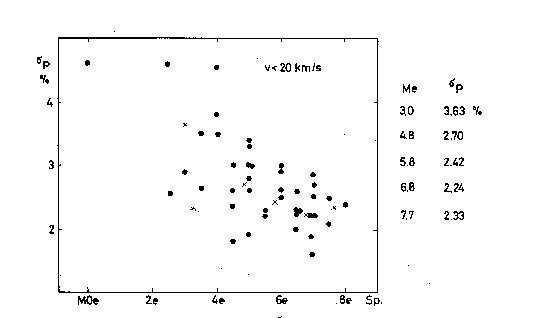 Fig. 1
The maxima of the short period stars are more pointed than those of
the long period stars and therefore we should expect that the observational
part of the scattering is smaller for short period stars than for long period
objects. Another argument is the following: From 125 maxima obtained
by two experienced observers (by Nijland and me and by Loreta and me)
I found a mean error of only +-2.5d or roughly 1% of the period for each
maximum, if the mean value has been regarded to be correct. Therefore
a rest of true physical relation remains in the sense that the shorter the
period and the earlier the spectrum the larger the scattering of the cycles.
The rapidly moving stars show the same behaviour (Figure 3). The
correlation seems to be steeper but this is only an effect of the shortness of
Fig. 1
The maxima of the short period stars are more pointed than those of
the long period stars and therefore we should expect that the observational
part of the scattering is smaller for short period stars than for long period
objects. Another argument is the following: From 125 maxima obtained
by two experienced observers (by Nijland and me and by Loreta and me)
I found a mean error of only +-2.5d or roughly 1% of the period for each
maximum, if the mean value has been regarded to be correct. Therefore
a rest of true physical relation remains in the sense that the shorter the
period and the earlier the spectrum the larger the scattering of the cycles.
The rapidly moving stars show the same behaviour (Figure 3). The
correlation seems to be steeper but this is only an effect of the shortness of
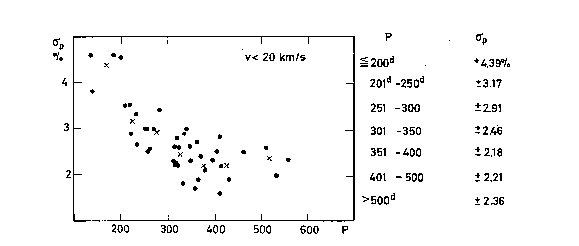 Fig. 2
Fig. 2
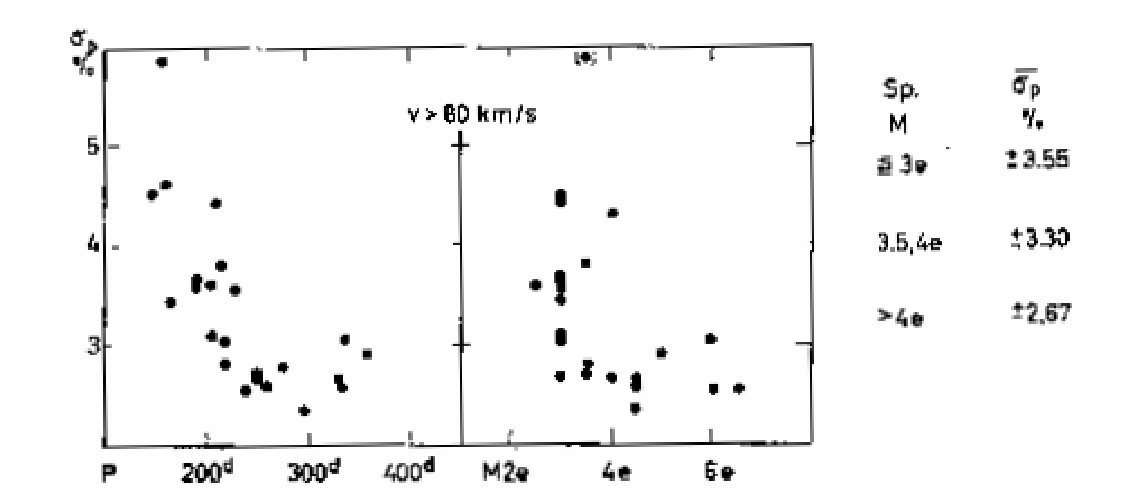 Fig. 3
these periods. If we draw the diagram for all 65 objects, the slowly moving
stars give precisely the same relation as the rapidly moving ones (Figure 4).
One can state: If there exists a chemical difference between population
I and population II Me-stars, the mechanism of the variability is obviously not
influenced. Both groups behave much more in the same way than the classical
Cepheids and the W Vir-stars.
Only the relation between the amplitudes and the scattering of the
cycles shows an insignificant difference between the two groups (Figure 5).
The scattering of the cycles is slightly greater for rapidly moving stars than
for slowly moving objects of the same amplitude. If we form groups of about
seven to ten stars, the difference becomes evident, though it remains small.
The greater scattering of the cycles of small amplitude variables in both
groups is caused partially by the fact that their maxima are mostly very
flat and therefore difficult to observe. But only for stars with shorter periods
than 200d are the amplitudes of the rapidly moving stars significantly smaller.
Fig. 3
these periods. If we draw the diagram for all 65 objects, the slowly moving
stars give precisely the same relation as the rapidly moving ones (Figure 4).
One can state: If there exists a chemical difference between population
I and population II Me-stars, the mechanism of the variability is obviously not
influenced. Both groups behave much more in the same way than the classical
Cepheids and the W Vir-stars.
Only the relation between the amplitudes and the scattering of the
cycles shows an insignificant difference between the two groups (Figure 5).
The scattering of the cycles is slightly greater for rapidly moving stars than
for slowly moving objects of the same amplitude. If we form groups of about
seven to ten stars, the difference becomes evident, though it remains small.
The greater scattering of the cycles of small amplitude variables in both
groups is caused partially by the fact that their maxima are mostly very
flat and therefore difficult to observe. But only for stars with shorter periods
than 200d are the amplitudes of the rapidly moving stars significantly smaller.
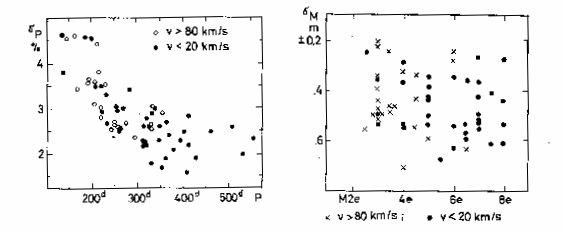 Fig. 4
Fig. 4
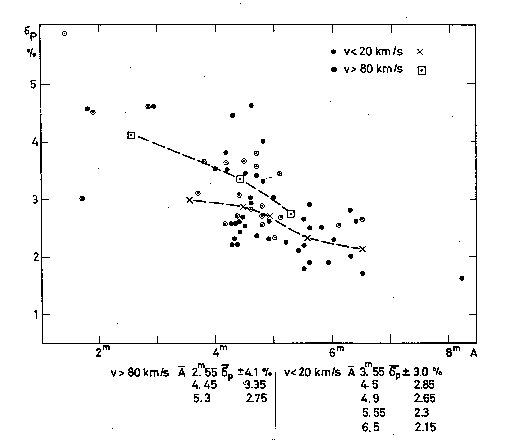 Fig. 5
For periods longer than 200d the amplitudes of the two groups are nearly equal
(see Table 2).
Table 2
Period < 200d 200d-299d 300d-399d > 400d
v > 80 km/s mean(A) = 2.67m 4.53m 4.78m -
v < 20 km/s mean(A) = 3.83 4.40 5.08 5.88m
all mean(A) = 3.05 4.47 5.02 5.88
Finally it may be of interest to notice that no relation could be found
between the scattering of the maximum magnitudes and any other property.
Diagram 6 gives an example of this fact. Each sub-group of Me contains stars
with high and with small scattering of the maximum brightness.
Fig. 5
For periods longer than 200d the amplitudes of the two groups are nearly equal
(see Table 2).
Table 2
Period < 200d 200d-299d 300d-399d > 400d
v > 80 km/s mean(A) = 2.67m 4.53m 4.78m -
v < 20 km/s mean(A) = 3.83 4.40 5.08 5.88m
all mean(A) = 3.05 4.47 5.02 5.88
Finally it may be of interest to notice that no relation could be found
between the scattering of the maximum magnitudes and any other property.
Diagram 6 gives an example of this fact. Each sub-group of Me contains stars
with high and with small scattering of the maximum brightness.
 Fig. 1
The maxima of the short period stars are more pointed than those of
the long period stars and therefore we should expect that the observational
part of the scattering is smaller for short period stars than for long period
objects. Another argument is the following: From 125 maxima obtained
by two experienced observers (by Nijland and me and by Loreta and me)
I found a mean error of only +-2.5d or roughly 1% of the period for each
maximum, if the mean value has been regarded to be correct. Therefore
a rest of true physical relation remains in the sense that the shorter the
period and the earlier the spectrum the larger the scattering of the cycles.
The rapidly moving stars show the same behaviour (Figure 3). The
correlation seems to be steeper but this is only an effect of the shortness of
Fig. 1
The maxima of the short period stars are more pointed than those of
the long period stars and therefore we should expect that the observational
part of the scattering is smaller for short period stars than for long period
objects. Another argument is the following: From 125 maxima obtained
by two experienced observers (by Nijland and me and by Loreta and me)
I found a mean error of only +-2.5d or roughly 1% of the period for each
maximum, if the mean value has been regarded to be correct. Therefore
a rest of true physical relation remains in the sense that the shorter the
period and the earlier the spectrum the larger the scattering of the cycles.
The rapidly moving stars show the same behaviour (Figure 3). The
correlation seems to be steeper but this is only an effect of the shortness of
 Fig. 2
Fig. 2
 Fig. 3
these periods. If we draw the diagram for all 65 objects, the slowly moving
stars give precisely the same relation as the rapidly moving ones (Figure 4).
One can state: If there exists a chemical difference between population
I and population II Me-stars, the mechanism of the variability is obviously not
influenced. Both groups behave much more in the same way than the classical
Cepheids and the W Vir-stars.
Only the relation between the amplitudes and the scattering of the
cycles shows an insignificant difference between the two groups (Figure 5).
The scattering of the cycles is slightly greater for rapidly moving stars than
for slowly moving objects of the same amplitude. If we form groups of about
seven to ten stars, the difference becomes evident, though it remains small.
The greater scattering of the cycles of small amplitude variables in both
groups is caused partially by the fact that their maxima are mostly very
flat and therefore difficult to observe. But only for stars with shorter periods
than 200d are the amplitudes of the rapidly moving stars significantly smaller.
Fig. 3
these periods. If we draw the diagram for all 65 objects, the slowly moving
stars give precisely the same relation as the rapidly moving ones (Figure 4).
One can state: If there exists a chemical difference between population
I and population II Me-stars, the mechanism of the variability is obviously not
influenced. Both groups behave much more in the same way than the classical
Cepheids and the W Vir-stars.
Only the relation between the amplitudes and the scattering of the
cycles shows an insignificant difference between the two groups (Figure 5).
The scattering of the cycles is slightly greater for rapidly moving stars than
for slowly moving objects of the same amplitude. If we form groups of about
seven to ten stars, the difference becomes evident, though it remains small.
The greater scattering of the cycles of small amplitude variables in both
groups is caused partially by the fact that their maxima are mostly very
flat and therefore difficult to observe. But only for stars with shorter periods
than 200d are the amplitudes of the rapidly moving stars significantly smaller.
 Fig. 4
Fig. 4
 Fig. 5
For periods longer than 200d the amplitudes of the two groups are nearly equal
(see Table 2).
Table 2
Period < 200d 200d-299d 300d-399d > 400d
v > 80 km/s mean(A) = 2.67m 4.53m 4.78m -
v < 20 km/s mean(A) = 3.83 4.40 5.08 5.88m
all mean(A) = 3.05 4.47 5.02 5.88
Finally it may be of interest to notice that no relation could be found
between the scattering of the maximum magnitudes and any other property.
Diagram 6 gives an example of this fact. Each sub-group of Me contains stars
with high and with small scattering of the maximum brightness.
Fig. 5
For periods longer than 200d the amplitudes of the two groups are nearly equal
(see Table 2).
Table 2
Period < 200d 200d-299d 300d-399d > 400d
v > 80 km/s mean(A) = 2.67m 4.53m 4.78m -
v < 20 km/s mean(A) = 3.83 4.40 5.08 5.88m
all mean(A) = 3.05 4.47 5.02 5.88
Finally it may be of interest to notice that no relation could be found
between the scattering of the maximum magnitudes and any other property.
Diagram 6 gives an example of this fact. Each sub-group of Me contains stars
with high and with small scattering of the maximum brightness.